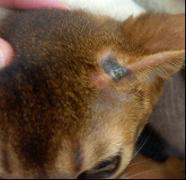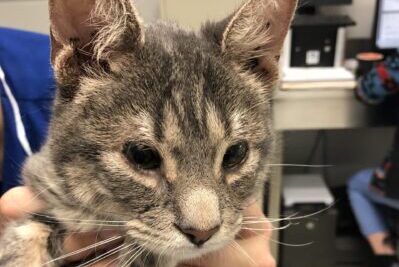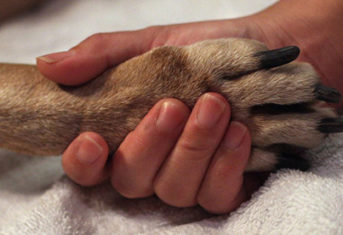Spa Day for Kittens

Spa Day for Kittens
Abyssinian kittens Elizabeth Barbara and Moby came to The AMC for a spa day of sorts. Below, you can watch a video of Elizabeth in the tub. Readers of Fur the Love of Pets know these kittens from their debut in the “ABC’s of Feline DNA.”
When their owner called to alert me of a dark spot near Elizabeth’s ear, I was concerned one of these rambunctious kittens had gotten burned. But because kittens are prone to a fungal infection known as ringworm, I sent a hair sample to the lab for testing. About two days before the result came back from the lab, Moby developed a similar lesion on his ear and then I knew it was ringworm. At that time I prescribed a topical antifungal cream called ketoconazole, and when the lab confirmed the result it was time for a bath.
Dermatophytosis
Ringworm is the most common infectious and contagious skin disease in cats and gets its name from the characteristic ring lesion seen in humans. WebMD has a slideshow demonstrating the appearance of the characteristic skin lesions.
Dermatophytosis is the scientific name for ringworm, which in cats is typically caused by the organism Microsporum canis. This fungus requires a break in the skin to cause infection. The photograph doesn’t show the marks, but Elizabeth had punctures around the base of her ear about the same width as the space between Moby’s fangs. Because their immune system is not fully mature, kittens more commonly contract ringworm than adult cats.
Scabby, scaly kittens
The clinical hallmarks of ringworm in cats are hair loss, hair breakage, scaling, and crusting of the skin. Infected cats may be very itchy. Like Moby and Elizabeth, most lesions occur on the face, ears, and paws. In some cats, ringworm lesions spread all over the body.
The gift of ringworm
We will never know where these kittens came into contact with M. canis, since it is ubiquitous within the environment and also carried on the fur of cats. We do know they gave the infection to their family. One of the first things I did when I suspected ringworm was to ask the family if they had any skin lesions and to warn them about the possibility. I also wrote down what I though the kittens might have on my prescription pad so the human dermatologist could call me if need be. Communication between veterinarians and physicians is critical in cases of zoonotic disease – diseases passed between animals and man.
The spa day
A bath is part of the treatment for ringworm. Additionally, oral and topical antifungals are often used. This is no flowery, bubbly soak. We rinse ringworm patients with lime sulfur dip, which is more like “taking the cure” at Saratoga Springs than spending a day at Elizabeth Arden. Lime sulfur carries the pungent odor of rotten eggs and on the day of the bath, someone commented the bathing area smelled like a chemistry lab where the experiment had gone badly. The smell may have been bad, but the bath went well and the hair is already growing back in on Moby’s and Elizabeth’s ears.
________________________________________________________
This may also be found in the Tales from the Pet Clinic blog on WebMD.com.
For over a century, The Animal Medical Center has been a national leader in animal health care, known for its expertise, innovation and success in providing routine, specialty and emergency medical care for companion animals. Thanks in part to the enduring generosity of donors, The AMC is also known for its outstanding teaching, research and compassionate community funds. Please help us to continue these efforts. Send your contribution to: The Animal Medical Center, 510 East 62nd Street, New York, NY 10065. For more information, visit www.amcny.org. To make an appointment, please call 212.838.7053.


































